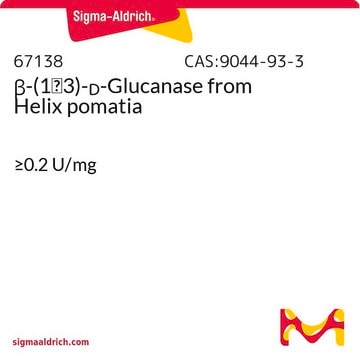V900511
Cellulase from Aspergillus niger
Vetec™, reagent grade
Sinonimo/i:
1,4-(1,3:1,4)-β-D-Glucan 4-glucanohydrolase
Autenticatiper visualizzare i prezzi riservati alla tua organizzazione & contrattuali
About This Item
Origine biologica
Aspergillus niger
Grado
reagent grade
Nome Commerciale
Vetec™
Stato
solid
cellulase activity
≥0.3 units/mg solid
Temperatura di conservazione
2-8°C
Cerchi prodotti simili? Visita Guida al confronto tra prodotti
Azioni biochim/fisiol
Cellulase from Aspergillus niger catalyzes the hydrolysis of endo-1,4-β-D-glycosidic linkages in cellulose, lichenin, barley glucan, and the cellooligosaccharides cellotriose to cellohexaose. It does not cleave cellobiose or p-nitrophenyl-β-D-glucoside. This enzyme will also cleave intact glycosaminoglycan from a core peptide by hydrolyzing the xylosyl serine linkage.
Altre note
View more information on enzymes for complex carbohydrate analysis at www.sigma-aldrich.com/enzymeexplorer
Note legali
Vetec is a trademark of Merck KGaA, Darmstadt, Germany
Avvertenze
Danger
Indicazioni di pericolo
Consigli di prudenza
Classi di pericolo
Resp. Sens. 1
Codice della classe di stoccaggio
11 - Combustible Solids
Classe di pericolosità dell'acqua (WGK)
WGK 1
Punto d’infiammabilità (°F)
Not applicable
Punto d’infiammabilità (°C)
Not applicable
Scegli una delle versioni più recenti:
Certificati d'analisi (COA)
Lot/Batch Number
Non trovi la versione di tuo interesse?
Se hai bisogno di una versione specifica, puoi cercare il certificato tramite il numero di lotto.
Possiedi già questo prodotto?
I documenti relativi ai prodotti acquistati recentemente sono disponibili nell’Archivio dei documenti.
I clienti hanno visto anche
David N Bryant et al.
Bioresource technology, 128, 765-768 (2012-12-12)
Dielectric spectroscopy (DS) has been used to monitor the simultaneous saccharification and fermentation of lignocellulosic biomass by measuring its dielectric state. However, it is unknown whether following steam explosion (SE) pre-treatment, lignocellulose would still maintain a dielectric state, and, if
Wei Weiqi et al.
Bioresource technology, 128, 725-730 (2012-12-25)
Combination of liquid hot water pretreatment (LHWP) and wet disk milling (WDM) was investigated in this study to enhance the sugar recovery yield both in prehydrolyzate and enzymatic hydrolyzate. The results show that WDM with LHWP at 180 °C for
Antonella Amore et al.
Microbial cell factories, 11, 164-164 (2012-12-27)
The use of lignocellulosic materials for second generation ethanol production would give several advantages such as minimizing the conflict between land use for food and fuel production, providing less expensive raw materials than conventional agricultural feedstock, allowing lower greenhouse gas
Mark A Currie et al.
The Journal of biological chemistry, 288(11), 7978-7985 (2013-01-24)
Clostridium thermocellum produces the prototypical cellulosome, a large multienzyme complex that efficiently hydrolyzes plant cell wall polysaccharides into fermentable sugars. This ability has garnered great interest in its potential application in biofuel production. The core non-catalytic scaffoldin subunit, CipA, bears
Margaret Buchanan et al.
BMC plant biology, 12, 235-235 (2012-12-13)
Endo-(1,4)-β-glucanase (cellulase) glycosyl hydrolase GH9 enzymes have been implicated in several aspects of cell wall metabolism in higher plants, including cellulose biosynthesis and degradation, modification of other wall polysaccharides that contain contiguous (1,4)-β-glucosyl residues, and wall loosening during cell elongation.
Il team dei nostri ricercatori vanta grande esperienza in tutte le aree della ricerca quali Life Science, scienza dei materiali, sintesi chimica, cromatografia, discipline analitiche, ecc..
Contatta l'Assistenza Tecnica.





